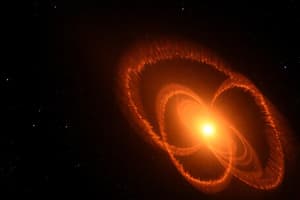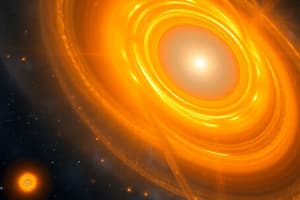Podcast
Questions and Answers
What is the primary goal of averaging data when searching for pulsars?
What is the primary goal of averaging data when searching for pulsars?
- To shorten the detection period
- To prevent the pulse from being blurred (correct)
- To minimize the computational resources required
- To maximize the number of pulses detected
What significant achievement did Joseph Taylor and Russell Hulse accomplish?
What significant achievement did Joseph Taylor and Russell Hulse accomplish?
- Discovery of the first pulsar in a binary system
- Detection of the Crab pulsar
- Building the first digital pulsar detection system
- Finding 40 new pulsars (correct)
Why did Hulse set the threshold for pulsar detection at 7 standard deviations?
Why did Hulse set the threshold for pulsar detection at 7 standard deviations?
- To simplify the detection process
- To ensure a high likelihood of false positives
- To reduce the number of signals needing verification
- To guarantee the signal was not random noise (correct)
What was the frequency range used by Taylor and Hulse during their pulsar searches?
What was the frequency range used by Taylor and Hulse during their pulsar searches?
What characteristic of the Arecibo telescope contributes to its effectiveness in pulsar detection?
What characteristic of the Arecibo telescope contributes to its effectiveness in pulsar detection?
How long did Taylor and Hulse perform their observations for pulsars?
How long did Taylor and Hulse perform their observations for pulsars?
What is one potential issue when averaging data using a guess for the period?
What is one potential issue when averaging data using a guess for the period?
What was the period of the special pulsar discovered by Taylor and Hulse?
What was the period of the special pulsar discovered by Taylor and Hulse?
What physical phenomenon did Hulse observe in the pulsar's period?
What physical phenomenon did Hulse observe in the pulsar's period?
How many neutron stars are involved in the pulsar binary system identified by Hulse and Taylor?
How many neutron stars are involved in the pulsar binary system identified by Hulse and Taylor?
What key theoretical concept did Einstein introduce that affects the motion of massive objects?
What key theoretical concept did Einstein introduce that affects the motion of massive objects?
What ultimately happens to the two neutron stars in the binary system as their orbit decays?
What ultimately happens to the two neutron stars in the binary system as their orbit decays?
How frequently do the two neutron stars orbit each other?
How frequently do the two neutron stars orbit each other?
What kind of waves do neutron stars radiate as a result of their gravitational interaction?
What kind of waves do neutron stars radiate as a result of their gravitational interaction?
What does the pulsar's signal reveal when it is positioned nearly behind another star?
What does the pulsar's signal reveal when it is positioned nearly behind another star?
What prestigious award did Hulse and Taylor receive for their discoveries?
What prestigious award did Hulse and Taylor receive for their discoveries?
What characterizes young pulsars compared to old pulsars?
What characterizes young pulsars compared to old pulsars?
What happens to the emission of a pulsar as it ages?
What happens to the emission of a pulsar as it ages?
What unique event can occur with millisecond pulsars?
What unique event can occur with millisecond pulsars?
In what type of system are millisecond pulsars typically formed?
In what type of system are millisecond pulsars typically formed?
What occurs when a massive star in a binary system goes supernova?
What occurs when a massive star in a binary system goes supernova?
How does the magnetic field strength change in old pulsars?
How does the magnetic field strength change in old pulsars?
What defines an extinct pulsar?
What defines an extinct pulsar?
What is a common trait of both young and millisecond pulsars?
What is a common trait of both young and millisecond pulsars?
What is required for a neutron star to be classified as a pulsar?
What is required for a neutron star to be classified as a pulsar?
How can noise in radio measurements be effectively reduced?
How can noise in radio measurements be effectively reduced?
What is the effect of interstellar dispersion on pulsar pulse timing?
What is the effect of interstellar dispersion on pulsar pulse timing?
Which method is NOT mentioned as a technique for measuring pulsars?
Which method is NOT mentioned as a technique for measuring pulsars?
What occurs to the amplitude of noise when averaging multiple signals?
What occurs to the amplitude of noise when averaging multiple signals?
What leads to a neutron star becoming a millisecond pulsar?
What leads to a neutron star becoming a millisecond pulsar?
What percentage of active pulsars in the Milky Way do we likely observe?
What percentage of active pulsars in the Milky Way do we likely observe?
What is a primary challenge in radio astronomy when detecting pulsars?
What is a primary challenge in radio astronomy when detecting pulsars?
How does the dispersion of pulsar signals affect the arrival time on Earth?
How does the dispersion of pulsar signals affect the arrival time on Earth?
Why are pulsar searches conducted at frequencies below 1 gigahertz?
Why are pulsar searches conducted at frequencies below 1 gigahertz?
What relationship does the Doppler shift have with finding extra planets or dark companions in the solar system?
What relationship does the Doppler shift have with finding extra planets or dark companions in the solar system?
Why is the radio noise generated by thermal emission significant for radio telescopes?
Why is the radio noise generated by thermal emission significant for radio telescopes?
How do changes in the interstellar medium affect pulsar pulse arrival times?
How do changes in the interstellar medium affect pulsar pulse arrival times?
At higher frequencies above 1 gigahertz, why is accurate timing of pulsars possible despite their weakness?
At higher frequencies above 1 gigahertz, why is accurate timing of pulsars possible despite their weakness?
What is the expected outcome of dispersive effects on pulsar signals with a frequency decrease by a factor of 2?
What is the expected outcome of dispersive effects on pulsar signals with a frequency decrease by a factor of 2?
What would happen if the input to a radio telescope was blocked by an object at room temperature?
What would happen if the input to a radio telescope was blocked by an object at room temperature?
Flashcards are hidden until you start studying
Study Notes
Normal Pulsars
- Pulsars are neutron stars, remnants of collapsed cores of massive stars
- Young pulsars rotate rapidly and possess strong magnetic fields
- Old pulsars have weaker magnetic fields and rotate slower
- Millisecond pulsars are rejuvenated old pulsars with weak magnetic fields but rapid rotations
- Millisecond pulsars form in binary systems through mass transfer from a companion star
- Not all neutron stars are pulsars, only those with strong magnetic fields and beams that point towards Earth
- Most pulsars are not observed due to narrow beams and a small chance of intersecting the Earth
- Detecting pulsars relies on averaging noisy signals over time and frequency to distinguish signal from noise
- Interstellar dispersion causes pulse arrival times to vary based on frequency, requiring adjustments to data before analyzing
- Accuracy of pulsar measurements enables determining spin-down rate and dispersion measure, which allows prediction of pulse timing
- Finding new pulsars involves searching for signals with specific periods, dispersion, and pulse shapes within noisy data
- An example of the use of pulsars to confirm Einstein's theory of relativity is the discovery of a pulsar in a binary system
- The binary pulsar system confirms the existence of gravitational waves and their effect on the orbital decay of the binary system, ultimately leading to a merger
- Measuring the delay of pulsar signals due to the curvature of space caused by a massive object provides direct evidence for Einstein's theory of relativity
Studying That Suits You
Use AI to generate personalized quizzes and flashcards to suit your learning preferences.





